
Wine Culture and Information since 2002 - Volume 22
 Wine Culture and Information since 2002 - Volume 22 |
|
Contrasts of Erbaluce di Caluso Spumante Brut and Trento BrutTwo sparkling wines compared in the glasses of this month's tasting by contrast. The Piedmontese Erbaluce in its sparkling version compared with the bubbles of Chardonnay and Pinot Noir from Trentino. |
|
Sparkling wines have always evoked the joy and cheerfulness of significant moments, often solemn, despite the fact they are now equally appreciated even in contexts in which there is no particular event to celebrate, if not good company and good food. Bubbles, undeniably, are capable of particular finesse and elegance, a quality we do not find in any other style of wine. This obviously does not mean other styles of wine are not capable of expressing elegance and finesse – indeed, the opposite is true – but it is undeniable that those expressed by quality sparkling wines are certainly unique. Not all sparkling wines are the same, of course, and depending on the grapes used for the production and, in particular, on the method of making the sparkling wine, the expression of their character – including finesse and elegance – changes substantially. From this point of view, the availability of sparkling wines is so wide in most of the wine-producing countries of the world, such as to satisfy anyone's curiosity and satisfaction. Not only in countries with a consolidated sparkling wine tradition – such as France, Italy and Spain – but also in emerging countries with a short history, where bubbles of sure interest are made. Thinking of sparkling wines produced with the classic method – that is with refermentation in bottle, a style to which the two wines we are examining this month belong – the grapes which are mainly associated, and with good reason, are Chardonnay and Pinot Noir. Varieties which, with classic method sparkling wines, reach peaks of indisputable excellence, are used all over the world for the production of this style of wine. However, time and experimentation have made it possible to discover other varieties capable of giving classic method sparkling wines of extraordinary finesse, elegance and complexity. For this reason, this month's tasting by contrast examines two classic method sparkling wines produced in different territories and with different grapes: Erbaluce di Caluso Spumante Brut, produced in Piedmont with the homonymous grape, and Trento Brut from Chardonnay and Pinot Noir.
|
|
Erbaluce is a white berried variety from Piedmont capable of making wines of considerable enological interest. This grape is in fact a rarity in the Italian wine scene, as its presence is almost exclusively recorded in its place of origin, that is in the territory of Caluso, in the Canavese area, north of Turin. Furthermore, Erbaluce is characterized by an interesting enological versatility such as to allow the production of dry white wines – certainly the best known style – as well as sweet wines from dried grapes and, lastly, classic method sparkling wines. The wines produced with this grape in the Caluso area are recognized by the Italian quality system as Denominazione d'Origine Controllata e Garantita (Denomination of Controlled and Guaranteed Origin, DOCG), providing for dry white, passito (sweet) and classic method sparkling wine styles. The denomination, for the sake of completeness, takes the name of “Erbaluce di Caluso” or, simply, “Caluso”, therefore giving the wines a strong identification with the place and territory of origin. A grape of uncertain origins, it is believed to be autochthonous of the Caluso area and the first written information dates back to 1606. This variety, in fact, is mentioned in the work “Della eccellenza e diversità dei vini che sulla montagna di Torino si fanno e del modo di farli” (On the excellence and diversity of the wines that are made on the Turin mountains and of the way of making them) by Giovan Battista Croce, jeweler of Duke Carlo Emanuele I. In this document we read Erbalus is a white grape taking its name from alba luce (white light) because of its characteristic of shining in the light, also underlining its good wine making quality. Genetic investigations conducted on this variety would suggest a probable derivation from Cascarolo Bianco, another ancient Piedmont variety. If it is true Erbaluce wines enjoy a long and consolidated history, the production of classic method sparkling wines is instead much more recent, started in the 1960s, becoming over time an identifying style both of the territory and of the variety. In accordance with the production disciplinary, Erbaluce di Caluso Spumante is produced with the classic method only and with 100% of the homonymous variety, the aging in the bottle on its lees must be at least 15 months.
|
||||
|
The territory of Trento is definitely among those which, in relatively recent times, has been capable to affirm its enological success through the production of classic method sparkling wines. Although the sparkling wine tradition of this territory is now decades long, the success associated to the territory and its name is a more recent event, culminating in the recognition of the Denominazione d'Origine Controllata (Denomination of Controlled Origin, DOC). This event, in fact, also introduced the use of a further definition for the classic method sparkling wines of this territory – Trentodoc – often used, even by producers, to such an extent that it is stated in the labels as well. The success of Trento's sparkling wines is evidently the result of the quality that has been expressed here for decades as well as the particular vocation of these lands for the production of classic method sparkling wines, well supported by the favorable geological and climatic conditions. The composition of Trento's sparkling wines – in accordance with its production disciplinary – is expressed by the varieties which more than others are used in the production of classic method sparkling wines: Chardonnay, Pinot Blanc, Pinot Noir and Pinot Meunier. These grapes can be used both blended together and alone, therefore allowing the producers wide wine making possibilities as well as expression, from the so-called Blanc de Blancs to the Blanc de Noirs, as well as Rosé. In accordance with the production disciplinary, Trento must referment in bottle and age on its lees for at least 15 months, while for the Riserva style this period cannot be less than 36 months. As far as vintage wines are concerned, the year of vintage can only be indicated for wines with at least 24 months of aging in the bottle with their lees. As regards the use of the grapes, although the disciplinary allows for four varieties, the most used ones are actually Chardonnay and Pinot Noir, leaving Pinot Blanc and Pinot Meunier a decidedly marginal role.
|
Before starting this month's tasting by contrast, let's get the two bottles we will pour into the glasses. In both cases, the style we are considering is brut, therefore sparkling wines with a sugar dosage between 6 and 12 grams per liter. A quantity that, it must be said, in case of the upper limit, can produce a sensation of evident sweetness, however slight, and which has the effect of defining the gustatory profile of the wine. The search for these two wines is not difficult, in particular Trento, a wine having a wide commercial spreading and practically found in every wine shop. In both cases we will choose wines sans année, that is “without vintage”, therefore non millésimés. Specifically, we will choose wines refermented and aged in bottle for a relatively short period of time and which for both denominations is 15 months. As far as the composition is concerned, we will pay attention to the one of Trento Brut, trying to get a bottle produced with Chardonnay and Pinot Noir, possibly in equal parts. The wines are poured into their respective tasting glasses at a temperature of 10 °C. (50 °F) Let's pour the two wines into their respective glasses and start this month's tasting by contrast, by examining Erbaluce di Caluso Spumante Brut. Let's hold the glass in vertical position and observe the wine from the side, in order to appreciate the development and quality of bubbles, that is of the so called perlage. From the bottom can be seen chains of tiny bubbles developing towards the top. Let's now observe the wine from above: the bubbles move towards the wall forming a “crown” of thin, almost creamy foam. Let's now tilt the glass over a white surface and observe the base. The color of Erbaluce di Caluso Spumante Brut is intense and brilliant straw yellow, with very high transparency. We now pay attention to the opening of the glass, in order to appreciate the nuances of the wine. We note a straw yellow color, often tending towards gold. Let's now pass to the evaluation of the appearance of Trento Brut, starting from the examination of bubbles. Also in this case they develop with very tiny and persistent chains which, once they reach the surface, are arranged neatly on the inner wall of the glass forming a thin and creamy crown. The color of Trento Brut is pretty similar to the previous wine: intense and brilliant straw yellow – with very high transparency – and straw yellow nuances. The olfactory profile of sparkling wines produced with the classic method is the result of the expression of different factors, many of which are of technological, therefore enological, derivation. To these factors are also added the specific olfactory qualities of the varieties used for the production which, according to the various making factors, can undergo substantial sensorial alterations. In this regard, the most important technological factors include the refermentation in bottle, the liqueur de tirage, the autolysis of the yeasts – which therefore impart their “character ” to the wine – the aging time in bottle and the composition of the so-called liqueur d'expédition. The expressive potential of the grapes used for the production of a sparkling wine therefore depends on the skill and competence of the wine maker, last but not least – and definitely, very important – on their quality at the time of harvesting and on the enological practices carried out for the production of the base wine. Let's continue our tasting by contrast and proceed with the evaluation of the olfactory profiles of Erbaluce di Caluso Spumante Brut and Trento Brut, starting from the wine produced in Piedmont. Let's hold the glass in vertical position and, without swirling, do the first smell in order to examine the so-called opening of the wine, that is the identifying and primary olfactory qualities. To the nose we perceive intense and clean aromas in which we recognize apple, plum and chamomile as well as a clean sensation reminiscent of bread crust. Let's now swirl the glass, in order to allow the development of the other aromas, and do the second smell. From the glass are now perceived aromas of hawthorn as well as pear, hazelnut, citrus fruits and grapefruit, to which are added the scent of yeast. Let's now pass to the evaluation of the olfactory profile of Trento Brut, therefore – without swirling the glass – let's do the first smell and examine the opening. To the nose we perceive intense and clean aromas of banana, acacia and raspberry as well as clean sensations of bread crust. After having swirled the glass, the olfactory profile of Trento Brut is completed with hawthorn, apple, pear, tangerine, plum, peach and pineapple as well as the olfactory contribution given by yeast. Let's now pass to the evaluation of the gustatory profiles of the two sparkling wines, starting – as in the previous two phases – from Erbaluce di Caluso Spumante Brut. Let's take a sip of the Piedmontese sparkling wine and evaluate the attack, that is the initial sensations perceived in the mouth at the first sip. The primary gustatory quality perceived is the effervescence produced by carbon dioxide, clearly perceptible and not excessive with respect to the balance of the wine. We can also perceive the crispness given by the acidity and which finds the right balance both by the effect of alcohol and by the sensation of slight sweetness produced by the liqueur d'expedition which, according to the brut style, can also be 12 grams of sugar per liter. In the mouth we perceive flavors of apple, plum and hazelnut, therefore expressing good correspondence to the nose. Let's move on to the evaluation of the gustatory profile of Trento Brut and take a sip. Also in this case the attack is characterized by the pleasing effervescence produced by carbon dioxide, in perfect balance with the other gustatory sensations of the wine. We can perceive the evident crispness of acidity, also in this case well balanced both by alcohol and by the slight sweetness and roundness of the wine. In the mouth, finally, we perceive flavors of banana, apple, raspberry and tangerine. The last phase of our tasting by contrast examines the final sensations the two wines leave in the mouth after swallowing, in particular, the taste-olfactory persistence. As it is known, this indicator is expressed by the time during which it is possible to perceive taste-olfactory sensorial stimuli after swallowing and before their decay, a primary indicator of wine quality. The finish of Erbaluce di Caluso Spumante Brut is persistent and in the mouth we continue to perceive both the crispness of acidity and the pleasing hint of sweetness combined with a perceptible roundness. We also continue to perceive the flavors of apple, plum and hazelnut. The finish of Trento Brut is persistent, leaving in the mouth the pleasing sensation of crispness well balanced by the slight sweetness produced by the liqueur d'expedition and the almost creamy roundness given both by time and by the contribution of the Chardonnay grape. In the mouth we continue to perceive the flavors of banana, apple, raspberry and tangerine. Before ending the tasting, let's place the two glasses side by side and do a last smell, first Erbaluce di Caluso Spumante Brut and then Trento Brut: the differences between the two wines are clearly perceptible.
|
||||||||
Wines of the Month |
|
|
|
Score legend Prices are to be considered as indicative. Prices may vary according to the country or the shop where wines are bought |
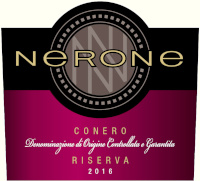
|
|
Conero Riserva Nerone 2016 |
|
| Terre Cortesi Moncaro (Marches, Italy) | |
 Montepulciano Montepulciano | |
| Price: € 30.00 | Score: |
 Deep ruby red and nuances of garnet red, little transparency. Deep ruby red and nuances of garnet red, little transparency. Intense, clean, pleasing, refined and elegant, starts with hints of
blueberry, black cherry and plum followed by aromas of dried violet,
blackberry, chocolate, tobacco, carob, cinnamon, pink pepper, licorice,
coffee, leather, vanilla and menthol. Intense, clean, pleasing, refined and elegant, starts with hints of
blueberry, black cherry and plum followed by aromas of dried violet,
blackberry, chocolate, tobacco, carob, cinnamon, pink pepper, licorice,
coffee, leather, vanilla and menthol.
 Properly tannic attack and however balanced by alcohol, good body,
intense flavors, agreeable. Properly tannic attack and however balanced by alcohol, good body,
intense flavors, agreeable.
 Persistent finish with flavors of blueberry, black cherry and plum. Persistent finish with flavors of blueberry, black cherry and plum. 15 months in barrique, 12 months in bottle. 15 months in barrique, 12 months in bottle. |
|
 Game, Roasted meat, Braised and stewed meat, Hard cheese Game, Roasted meat, Braised and stewed meat, Hard cheese |
|

|
|
Verdicchio dei Castelli di Jesi Passito Tordiruta 2017 |
|
| Terre Cortesi Moncaro (Marches, Italy) | |
 Verdicchio Verdicchio | |
| Price: € 30.00 - 500ml | Score: |
 Brilliant amber yellow and nuances of amber yellow, transparent. Brilliant amber yellow and nuances of amber yellow, transparent. Intense, clean, pleasing, refined and elegant, starts with hints of
raisin, dried fig and dried apricot followed by aromas of quince jam, peach
jam, citrus fruit peel, date, honey, candied fruits, lychee, saffron,
almond, vanilla and nail polish. Intense, clean, pleasing, refined and elegant, starts with hints of
raisin, dried fig and dried apricot followed by aromas of quince jam, peach
jam, citrus fruit peel, date, honey, candied fruits, lychee, saffron,
almond, vanilla and nail polish.
 Sweet and round attack, however balanced by alcohol, good body, intense
flavors, pleasing crispness. Sweet and round attack, however balanced by alcohol, good body, intense
flavors, pleasing crispness.
 Persistent finish with flavors of raisin, dried fig and dried apricot. Persistent finish with flavors of raisin, dried fig and dried apricot. 12 months in barrique, 12 months in bottle. 12 months in barrique, 12 months in bottle. |
|
 Jam and dried fruit tarts, Confectionery, Hard and piquant cheese Jam and dried fruit tarts, Confectionery, Hard and piquant cheese |
|
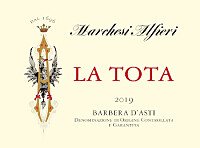
|
|
Barbera d'Asti La Tota 2019 |
|
| Marchesi Alfieri (Piedmont, Italy) | |
 Barbera Barbera | |
| Price: € 14.00 | Score: |
 Intense ruby red and nuances of ruby red, little transparency. Intense ruby red and nuances of ruby red, little transparency. Intense, clean, pleasing and refined, starts with hints of cherry, plum
and raspberry followed by aromas of violet, blueberry, strawberry, cocoa,
tobacco and vanilla. Intense, clean, pleasing and refined, starts with hints of cherry, plum
and raspberry followed by aromas of violet, blueberry, strawberry, cocoa,
tobacco and vanilla.
 Properly tannic attack and however balanced by alcohol, good body,
intense flavors, pleasing crispness. Properly tannic attack and however balanced by alcohol, good body,
intense flavors, pleasing crispness.
 Persistent finish with flavors of cherry, plum and raspberry. Persistent finish with flavors of cherry, plum and raspberry. Aged in cask and barrique. Aged in cask and barrique. |
|
 Stuffed pasta with mushrooms, Broiled meat and barbecue, Stewed meat with mushrooms, Roasted meat Stuffed pasta with mushrooms, Broiled meat and barbecue, Stewed meat with mushrooms, Roasted meat |
|
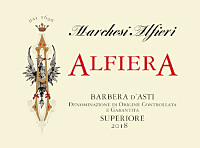
|
|
Barbera d'Asti Superiore Alfiera 2018 |
|
| Marchesi Alfieri (Piedmont, Italy) | |
 Barbera Barbera | |
| Price: € 28.00 | Score: |
 Deep ruby red and nuances of ruby red, little transparency. Deep ruby red and nuances of ruby red, little transparency. Intense, clean, pleasing, refined and elegant, starts with hints of
cherry, plum and violet followed by aromas of blackberry, blueberry,
chocolate, cinnamon, tobacco, pink pepper, leather, mace, licorice, vanilla
and menthol. Intense, clean, pleasing, refined and elegant, starts with hints of
cherry, plum and violet followed by aromas of blackberry, blueberry,
chocolate, cinnamon, tobacco, pink pepper, leather, mace, licorice, vanilla
and menthol.
 Properly tannic attack and however balanced by alcohol, good body,
intense flavors, pleasing crispness. Properly tannic attack and however balanced by alcohol, good body,
intense flavors, pleasing crispness.
 Persistent finish with flavors of cherry, plum and blackberry. Persistent finish with flavors of cherry, plum and blackberry. Aged in cask and barrique. Aged in cask and barrique. |
|
 Broiled meat and barbecue, Roasted meat, Stewed and braised meat with mushrooms, Cheese Broiled meat and barbecue, Roasted meat, Stewed and braised meat with mushrooms, Cheese |
|
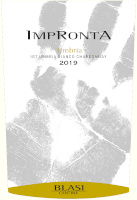
|
|
Impronta Bianco 2019 |
|
| Blasi (Umbria, Italy) | |
 Chardonnay Chardonnay | |
| Price: € 18.00 | Score: |
 Intense straw yellow and nuanced of straw yellow, very transparent. Intense straw yellow and nuanced of straw yellow, very transparent. Intense, clean, pleasing and refined, starts with hints of banana,
grapefruit and acacia followed by aromas of hawthorn, broom, apple,
pineapple, peach, butter, honey, praline and vanilla. Intense, clean, pleasing and refined, starts with hints of banana,
grapefruit and acacia followed by aromas of hawthorn, broom, apple,
pineapple, peach, butter, honey, praline and vanilla.
 Crisp attack and however balanced by alcohol, good body, intense
flavors, pleasing roundness. Crisp attack and however balanced by alcohol, good body, intense
flavors, pleasing roundness.
 Persistent finish with flavors of banana, grapefruit and apple. Persistent finish with flavors of banana, grapefruit and apple. 24 months in cask, at least 12 months in bottle. 24 months in cask, at least 12 months in bottle. |
|
 Pasta with legumes and meat, Roasted white meat, Roasted fish, Cheese Pasta with legumes and meat, Roasted white meat, Roasted fish, Cheese |
|
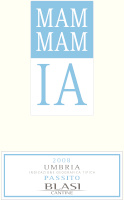
|
|
Mamma Mia 2008 |
|
| Blasi (Umbria, Italy) | |
 Malvasia Bianca (50%), Sémillon (30%), Chenin Blanc (20%) Malvasia Bianca (50%), Sémillon (30%), Chenin Blanc (20%) | |
| Price: € 25.00 - 50cl | Score: |
 Brilliant amber yellow and nuances of amber yellow, transparent. Brilliant amber yellow and nuances of amber yellow, transparent. Intense, clean, pleasing, refined and elegant, starts with hints of
raisin, dried fig and honey followed by aromas of apricot jam, orange
marmalade, date, candied fruits, medlar, lychee, caramel, hazelnut, almond,
saffron, vanilla and nail polish. Intense, clean, pleasing, refined and elegant, starts with hints of
raisin, dried fig and honey followed by aromas of apricot jam, orange
marmalade, date, candied fruits, medlar, lychee, caramel, hazelnut, almond,
saffron, vanilla and nail polish.
 Sweet and round attack, however balanced by alcohol, good body, intense
flavors, pleasing crispness. Sweet and round attack, however balanced by alcohol, good body, intense
flavors, pleasing crispness.
 Persistent finish with flavors of raisin, dried fig and honey. Persistent finish with flavors of raisin, dried fig and honey. Fermented in small barrels. 10 years in small barrels, 12 months in
bottle. Fermented in small barrels. 10 years in small barrels, 12 months in
bottle.
|
|
 Hard and piquant cheese, Dried fruit tarts, Confectionery Hard and piquant cheese, Dried fruit tarts, Confectionery |
|
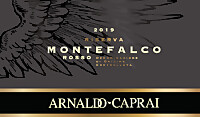
|
|
Montefalco Rosso Riserva 2019 |
|
| Arnaldo Caprai (Umbria, Italy) | |
 Sangiovese (70%), Sagrantino (15%), Merlot (15%) Sangiovese (70%), Sagrantino (15%), Merlot (15%) | |
| Price: € 21.00 | Score: |
 Deep ruby red and nuances of garnet red, little transparency. Deep ruby red and nuances of garnet red, little transparency. Intense, clean, pleasing, refined and elegant, starts with hints of
plum, black cherry and blackberry followed by aromas of dried violet, black
currant, blueberry, chocolate, tobacco, face powder, leather, licorice,
mace, vanilla and menthol. Intense, clean, pleasing, refined and elegant, starts with hints of
plum, black cherry and blackberry followed by aromas of dried violet, black
currant, blueberry, chocolate, tobacco, face powder, leather, licorice,
mace, vanilla and menthol.
 Properly tannic attack and however balanced by alcohol, good body,
intense flavors, pleasing roundness. Properly tannic attack and however balanced by alcohol, good body,
intense flavors, pleasing roundness.
 Persistent finish with flavors of plum, black cherry and blackberry. Persistent finish with flavors of plum, black cherry and blackberry. 20 months in barrique, at least 6 months in bottle. 20 months in barrique, at least 6 months in bottle. |
|
 Roasted meat, Braised and stewed meat with mushrooms, Hard cheese Roasted meat, Braised and stewed meat with mushrooms, Hard cheese |
|
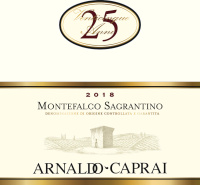
|
|
Montefalco Sagrantino 25 Anni 2018 |
|
| Arnaldo Caprai (Umbria, Italy) | |
 Sagrantino Sagrantino | |
| Price: € 55.00 | Score: |
 Deep ruby red and nuances of garnet red, little transparency. Deep ruby red and nuances of garnet red, little transparency. Intense, clean, pleasing, refined and elegant, starts with hints of
blackberry, plum and black cherry followed by aromas of dried violet,
peony, blueberry, cocoa, tobacco, face powder, cinnamon, mace, pink pepper,
leather, licorice, vanilla and menthol. Intense, clean, pleasing, refined and elegant, starts with hints of
blackberry, plum and black cherry followed by aromas of dried violet,
peony, blueberry, cocoa, tobacco, face powder, cinnamon, mace, pink pepper,
leather, licorice, vanilla and menthol.
 Tannic attack and however balanced by alcohol, full body, intense
flavors, agreeable. Tannic attack and however balanced by alcohol, full body, intense
flavors, agreeable.
 Very persistent finish with long flavors of blackberry, plum and black
cherry. Very persistent finish with long flavors of blackberry, plum and black
cherry.
 24 months in barrique, at least 8 months in bottle. 24 months in barrique, at least 8 months in bottle. |
|
 Game, Roasted meat, Stewed and braised meat, Hard cheese Game, Roasted meat, Stewed and braised meat, Hard cheese |
|
|
||||||||
|
DiWineTaste Polls
|
| |||||||
Privacy Policy | |||||||


| Copyright © 2002-2024 Antonello Biancalana, DiWineTaste - All rights reserved |
| All rights reserved under international copyright conventions. No part of this publication and of this WEB site may be
reproduced or utilized in any form or by any means, electronic or mechanical, without permission in writing from DiWineTaste. |